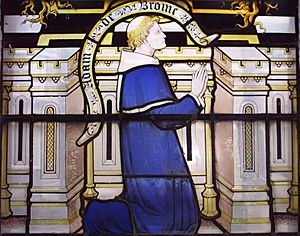Adam de Brome facts for kids

Adam de Brome (/də ˈbruːm/; died 16 June 1332) was an important person who worked for King Edward II. He is most famous for starting Oriel College in Oxford, England. Adam de Brome probably got his name from a place called Brome in Suffolk. Records show that his family had some land there.
Contents
Adam de Brome's Early Life and Work
Adam de Brome first appears in records around 1297. He was helping to collect food supplies in Dorset. In 1298, he was in Ireland. Later, in 1299, he was in charge of checking the quality of corn and wine. He also led soldiers from Yorkshire to Carlisle for a military campaign in Scotland.
He also worked on financial tasks. In 1305, he checked accounts for church taxes. In 1312, he helped to figure out taxes in the middle of England. Early in King Edward II's rule, Adam de Brome was one of the King's trusted clerks. He was sometimes asked to take care of important official seals. After 1311, he also worked as a judge, dealing with different types of legal cases.
Adam de Brome's Church Roles
In the 1300s, many royal officials were not paid directly with money. Instead, they were given income from church properties far away. Adam de Brome was one of these officials. He became a priest on March 2, 1301. Soon after, he became the rector (a type of church leader) of Wyck Rissington in Gloucestershire.
He held many other church positions over the years. These included being the Master of God's House in Dunwich in 1306. He was also a rector in places like Bridford, Devon, Handsworth, Yorkshire, and St Creed, Cornwall. He also held important roles in the diocese of Lincoln and at Wherwell Abbey in Hampshire. From 1320 to 1326, he was the rector of St Mary the Virgin in Oxford. He also managed St Bartholomew's Hospital in Oxford.
Founding Oriel College

Adam de Brome's most famous achievement was founding Oriel College. On April 28, 1324, King Edward II gave him permission to start a college for scholars. This college was meant for students to study different subjects, especially in honor of the Virgin Mary. Adam de Brome was allowed to set up the rules for how the college would be run.
Before the end of that year, Adam de Brome bought two buildings in Oxford for the college. The college was later named Oriel College. It was set up for studying theology (the study of religion) and logic. John de Laughton became the first leader, called a Rector.
On January 1, 1326, Adam de Brome officially gave the college properties to the King. A few weeks later, on January 21, the King issued a new official document for the college. In this new plan, the leader was called a Provost instead of a Rector. Adam de Brome was then named the first Provost of Oriel College. The college was given back the same buildings, Tackley's Inn and Perilous Hall.
New rules for the college were made in May 1326. These rules said the college needed a special seal. This seal would be kept in a box with three keys. One key was for the Provost, and the other two were for trusted scholars. The seal showed a picture of the Annunciation (a religious scene) with Adam de Brome kneeling below it. The rules also said that daily church services should be held at St Mary's for the souls of important people, including the King and Adam de Brome.
Death
Adam de Brome passed away in June 1332. He was buried on the north side of St Mary's Church in Oxford. Even though the church has been rebuilt over the years, his tomb is still there today.

